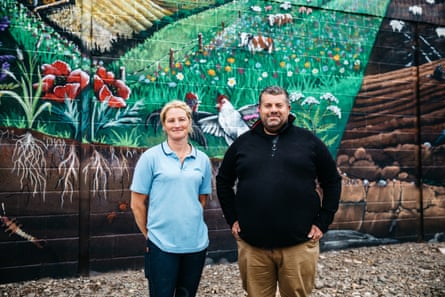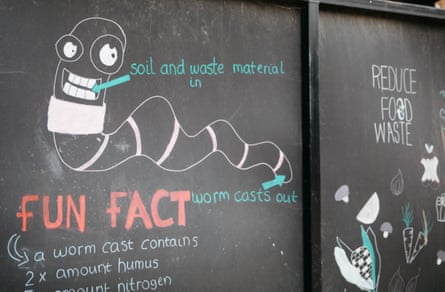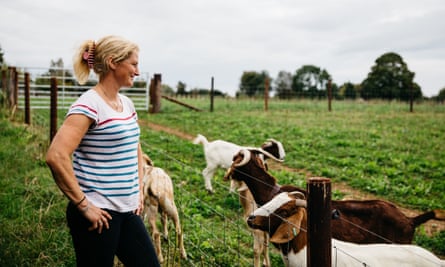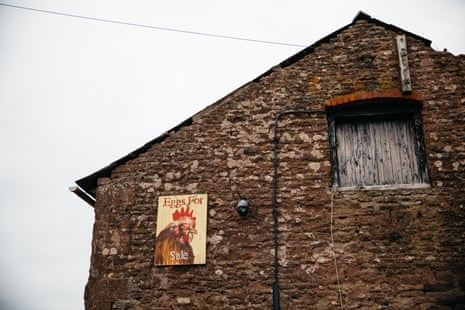The modern-day farm is rarely a thing of beauty. While a farmyard in Britain might for many still conjure up a bucolic idyll and freely roaming animals, the reality is often no more than a collection of bland metal sheds.
It turns out that a large, windowless, temperature-controlled shed can be the most efficient way to house and fatten up farm animals, particularly chickens. But among many downsides for the animals’ health and welfare, it is also leaving farmers miserable.
“Farmers choose a life on the land, but are forced to spend their time in sheds,” says Yorkshire-based farmer Chris Harrap, who has written about the impact of building design on farmers and livestock.
“For thousands of years farming had been about managing land and animals. Then suddenly people figured out we could move to intensive indoor methods and the same buildings went from storing stuff, to being where you spent a whole lot of time,” he says.
The result, says Harrap, is devastating for farmers’ mental health. He believes the comparatively high suicide rate in the sector may be connected to farmers’ day-to-day working environment.
“Human beings and animals need to interact with the natural world from which we came, but instead they’re spending all day inside an intensive indoor shed,” he says.
One farm trying to counter that narrative is run by Ben and Helen Taylor-Davies near Ross-on-Wye, Herefordshire.
Ben’s father tried to talk him out of his career choice, fearing farming was fast becoming a lonely profession, with most producers believing their futures relied on ever-bigger sheds and greater focus on just a few types of animals or crops.

In the US it is common for farms to have 40,000 cattle and not many humans – it’s surprising how few staff are needed to run an intensive livestock farm.
In contrast, Ben and Helen have decided to diversify and open up their farm to local businesses and the public, bringing as many people as possible on to their land on a regular basis.

The couple have put up more than a dozen signposts and there’s a series of walks, a farm shop, microbrewery and a converted barn used by local food businesses. “The biggest difference today is the diversity we have within the farm. I love to see people enjoying it,” says Ben.
“It’s about using your farm in a way others can enjoy too,” says Helen. “Most farmers are ‘get off my land’ but we’re very much ‘get on it’.”
The most popular addition has been a giant mural on the side of one of his barns, which, Ben says, always brings a smile to his face when he walks past. The burst of color and landscape has transformed a plain steel farm shed.
“We’ve got used to working in a mesh of greyness. A lot of times the farm is a very bland, dull place to work and if you’re not very happy it doesn’t go very well. It’s why we have such a huge mental health problem in farming,” says Ben.

Dull farm sheds are a symptom of a bigger problem with modern farming, says Harrap. While every farm had a shed, they were seasonal, used for part of the year for housing animals and at other times for storing hay, for example.
Harrap has been approached by farms wanting to “make their barns nicer”, but says “greenwashing” an intensive farm is not a solution.
“The real issue is intensive indoor rearing. It’s not about changing buildings, but changing the farming system to regenerative [which for him is mixed farms with a diversity of crops and animals].
“You can make a nice zero-grazing shed, but fundamentally people and animals need to be reintegrated with the land, not feeling like they’re in an industrial shed,” he says.

Farmers deserve sympathy rather than criticism from animal welfare activists for their working environments, says Harrap, as they struggle to cope with the compromises they see as necessary to stay in business.
“Modern farm setups restrict our ability to connect with animals, but it doesn’t mean farm workers don’t care about animals because they do. People feel they’re stuck. They need to know it’s OK to say ‘I’d rather walk around outside’. We need to criticize the system and provide dramatic sympathy for the people stuck in it.”
In the UK, the Samaritans can be contacted on 116 123. In the US, the National Suicide Prevention Hotline is 1-800-273-8255. In Australia, the crisis support service Lifeline is on 13 11 14. Hotlines in other countries can be found here. In the UK, The Farm Community Network helpline is also open from 7am-11pm every day of the year on 03000 111999.

Sign up for the Animals farmed monthly update to get a roundup of the best farming and food stories across the world and keep up with our investigations. You can send us your stories and thoughts at [email protected]
www.theguardian.com
George is Digismak’s reported cum editor with 13 years of experience in Journalism